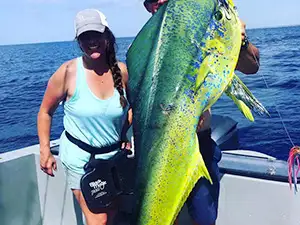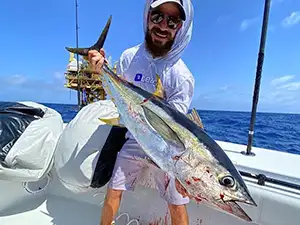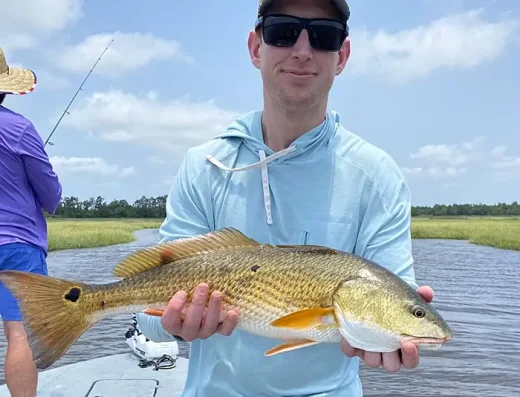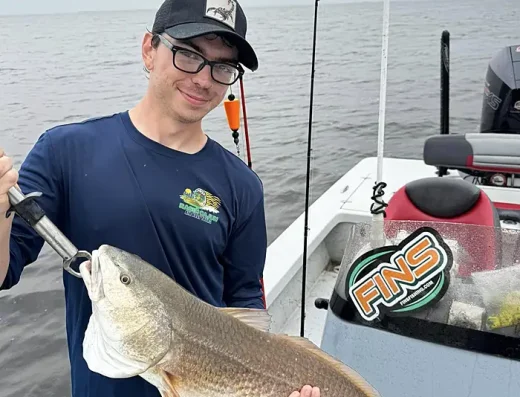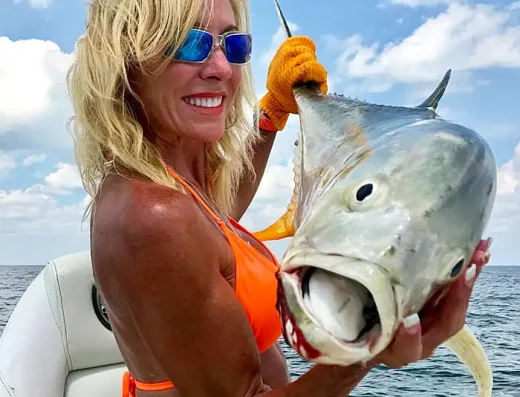Louisiana Fishing Charters
Louisiana fishing charters put you on redfish and speckled trout in the marsh, bull drum in the bays, bass in the bayous, and tuna far off the rigs.
TrustedFish connects anglers with proven local captains in Louisiana —no commissions, no pay-to-play listings, no BS. Every charter on our platform is invite-only, vetted for skill, local knowledge, and reputation. If they’re listed, they’ve earned it.
Top Rated Charters in Louisiana
Click to View destinations
Louisiana Fishing Guide
Louisiana’s fishing grounds stretch from the flooded cypress swamps of the Atchafalaya Basin to the bluewater oil rigs 60+ miles off the coast. What makes it different is how shallow and fertile everything is—the whole southern edge of the state is basically one big marsh system draining into the Gulf. You’ve got redfish cruising duck ponds, trout stacking up in the passes, and sheepshead crawling the bridges. Some captains run inshore trips barely a few miles from the launch, drifting oyster beds and cane banks. Others burn 100 gallons of fuel chasing yellowfin tuna 80 miles out of Venice.
The main charter types are half-day and full-day inshore trips out of Venice, Cocodrie, Delacroix, or Grand Isle—usually targeting reds, specks, and drum with shrimp under corks or soft plastics on jigheads. Light tackle is the name of the game, and most guides keep it simple. For offshore, trips get longer and pricier but the payoff’s real—big tuna, snapper, wahoo, and even swordfish. Most of that action is out of Venice, where the Mississippi River meets the Gulf and creates a bait-rich zone all year long. Boat ramps vary from paved launches in Delacroix to mud-packed slips in Pointe a la Hache, but locals know how to work with the tides and the runoff.
You’ll want to bring polarized glasses, bug spray (especially spring and early fall), and be ready to fish tight quarters in the marsh or long drifts out past the shelf. Louisiana doesn’t fish like Florida—it’s dirtier water, more baitfish, and more structure created by erosion, stumps, oil rigs, and tide changes. This state doesn’t give up fish easily, but when it turns on, there’s nothing else like it.
Regional Fishing Highlights
Venice and the Mississippi Delta
This stretch is ground zero for offshore fishing in Alabama. Boats run out to artificial reefs, oil rigs, and shelf edges. Red snapper’s the big draw during season, but there’s solid action year-round with amberjack, king mackerel, and cobia. Nearshore trips target Spanish mackerel and bonito trolling just outside Perdido Pass. Inshore charters stick to Oyster Bay and the ICW, where you’ll find redfish, trout, and the occasional tripletail around markers and crab trap buoys.
Delacroix and Hopedale Marsh
More protected than Venice, but just as fishy. Redfish, speckled trout, black drum, and sheepshead fill the inside waters. These trips are all about running narrow bayous and hitting cuts, points, and broken islands with popping corks or gold spoons. Most boats launch right off Reggio or Sweetwater. It’s more about numbers and sight-casting than size.
Cocodrie and Dularge
This area works great year-round. Trout and redfish dominate inshore, but the rigs just offshore also produce snapper and cobia in summer. Fishing the outer bays, like Sister Lake and Lake Barre, can be fire in spring and fall. Most charters launch early to beat the wind and chase moving bait schools on tide changes.
Grand Isle and Fourchon
Barrier island fishing with access to both inshore marsh and nearshore Gulf rigs. Spring brings trout to the beaches, fall pushes reds up into the island’s backside marshes. Sheepshead stack on the bridges. Further out, full-day trips chase king mackerel, snapper, and even the occasional mahi or sailfish when conditions line up.
Atchafalaya Basin and Spillway
This is a whole different world—swamp bass, sac-a-lait (crappie), and bream. Mostly freshwater, with some brackish areas depending on rainfall and flood stage. Anglers here work weed lines, cypress knees, and canal mouths using spinnerbaits and live minnows. No redfish here—but the largemouth can get big.
Fishing Seasons in Louisiana
Spring
Marshes warm up and baitfish start flooding in. Speckled trout fire up around cuts, points, and shell banks. Redfish feed shallow. Offshore, yellowfin tuna move in closer around the rigs, and the first big cobia start showing up. Crappie bite strong in the Basin before spawn ends.
Summer
Early mornings are best in the heat. Inshore trout get deeper, often found near passes and deeper bayous. Redfish move to the outer edges and can still be caught, but it’s tougher mid-day. Offshore is prime time—tuna, snapper, mahi, and marlin if you run far enough. Hydration matters.
Fall
Trout and redfish get aggressive again as water cools. This is a peak time for marsh trips—lots of action and lower crowds. Shrimp are thick in the bays, and everything feeds hard before winter. In freshwater, bass start feeding heavier on shad. Offshore tuna bite stays solid.
Winter
It’s cold by Louisiana standards, but fish still bite. Redfish move into deep holes and channels. Trout can be caught slow-drifting deep cuts. Calm days let some offshore trips run for tuna, but weather windows are tight. Freshwater action slows, but crappie still bite around structure.
Most Popular Gamefish in Louisiana
- Redfish – 18–40+ inches. Caught in marsh ponds, shorelines, and cuts using shrimp under corks, spoons, or live mullet.
- Speckled Trout – 12–25 inches. Found around oyster reefs, bay points, and passes. Soft plastics, live shrimp, or topwater early.
- Black Drum – 5–40+ pounds. Deeper holes and bridge structure. Live crab or shrimp on the bottom.
- Yellowfin Tuna – 30–150+ pounds. Offshore rigs and floaters. Live bait, vertical jigs, and chunk lines.
- Snapper – 2–20+ pounds. Caught near rigs and reefs on cut bait or live bait.
- Sheepshead – 2–8 pounds. Bridge pilings, rocks, and docks. Fiddler crabs or shrimp on small hooks.
- Largemouth Bass – 1–8 pounds. Backwater canals and flooded timber. Crankbaits, spinnerbaits, or soft plastics.
- Crappie – 0.5–2 pounds. Cypress trees and canal mouths in spillways. Live minnows or small jigs.
- Flounder – 1–5 pounds. Channels and sandy shorelines. Targeted with soft plastics or bull minnows.
Louisiana Fishing FAQs
Do I need a fishing license to go on a charter in Louisiana?
Yes, but many charter trips include a license in the cost or provide a “charter passenger license” through the captain. Ask ahead of time.
What’s the best time of year to fish in Louisiana?
Fall is hard to beat—cooler weather, active redfish and trout, and less boat traffic. Spring’s good too, especially for trout.
What bait works best for redfish in the marsh?
Live or dead shrimp under a popping cork is a go-to, but gold spoons and soft plastics also get the job done.
How far offshore do tuna trips run from Venice?
Anywhere from 30 to 100 miles, depending on the season and where the tuna are holding near rigs or floaters.
Can you fish freshwater and saltwater in the same day?
Absolutely. Around areas like Houma or Morgan City, you can start in the spillway and end up in brackish marsh by afternoon.
Are kids allowed on Louisiana fishing charters?
Yes—many inshore guides are family-friendly, with calm waters and easy access. Let the captain know the age range ahead of time.
What’s the water clarity like in the marsh?
It’s usually muddy or stained, especially near the river. But that’s normal—fish here use smell and vibration more than sight.
Where are the best places to catch big speckled trout?
Trout over 5 pounds show up near Lake Pontchartrain bridges, Calcasieu Lake, and certain passes in the fall and early spring.
Is fly fishing an option in Louisiana?
Yes—mostly for redfish. Some guides offer poling skiffs and sight-casting trips, especially around Hopedale, Delacroix, and Venice.

